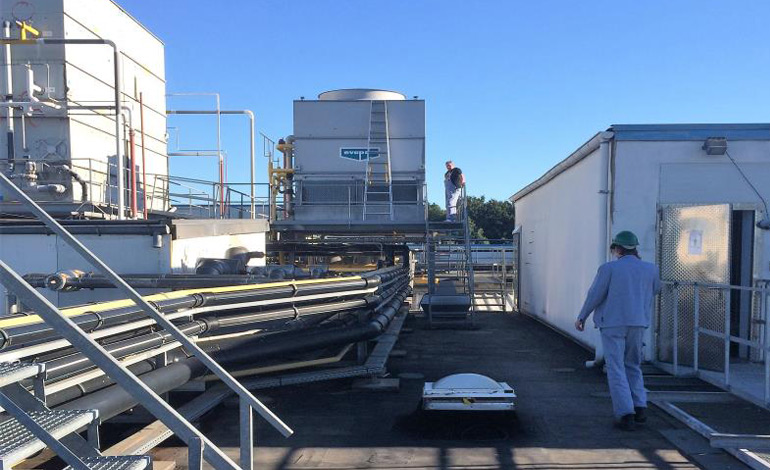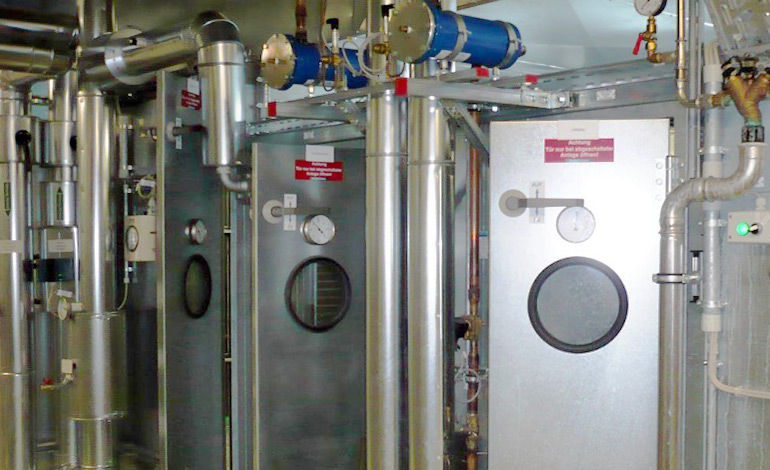Ensuring hygienic operations for evaporative cooling systems according to the VDI guideline 2047, sheet 2

The Task
Cooling towers are used where cooling water is required for process and machine cooling. Refrigeration systems tend to be used for cooling water temperatures below around +20°C, while cooling towers are used for higher temperatures.
The water to be cooled is sprayed using a water distribution system and percolated via fillers, whose shape provides for a long retention time for the water. Ambient air is introduced in a counterflow, causing a small part of the water to evaporate. The recooled water is collected in the floor tub and fed back into the cooling systems.
Risk
Due in part to their temperature range, a strong reproduction of legionella bacteria can occur in evaporative cooling systems if conditions are unfavourable. This may lead to water droplets (aerosols) being emitted, which may - when inhaled by human beings - cause severe pneumonia that may even result in death.
Legionella are water bacteria that occur in all bodies of freshwater. Water temperatures between 25°C and 45°C may favour enormous reproduction rates leading to significant health hazards. Risks can arise for both staff members working in the environment of aerosol generating units and for completely unrelated individuals, if aerosols are carried in the air.
This is why all water bearing systems must reliably comply with hygiene requirements to prevent health hazards.
The challenge
- Compliance with the parameters of the 42nd Federal Emission Control Act BImSchV (as of November 2016) and VDI 2047-2
- Risk assessment for cooling systems
- Hygienic operations of cooling systems and their maintenance measures
- Highest possible degree of water utilisation in order to optimise operating costs
- Preventing incrustations and corrosion in system components with water contact
- Preventing legionella bacteria and the formation of biofilms on cooling tower fittings, in particular during the summer months
- Optimised heat transfer using deposit-free heat exchangers
The solution
- Creating operating manuals for customers including maintenance and measure lists for evaporative cooling systems
- Preparing risk assessments for cooling systems
- Suitable choice of biocides to prevent micro-organisms from building up resistance
- Using suitable, highly effective stabilising and dispersing agents for highly densified cooling water with long retention periods and low flow conditions
- High chemical resistance of hardness stabilisers towards oxidative biocides
- Formation of corrosion protection
- Using UV technology
- Simple and trouble-free handling of FLOWCHEM® products
Benefits for our customers
- Expertise and experience of FLOWCHEM® staff according to VDI 2047, sheet 2
- Determination of potential risks and suitable measures for hygienic cooling water operations
- Reduced plant costs (water, electricity, chemicals)
- High degree of operational safety and availability of cooling systems
- Long maintenance intervals, less mechanical cleaning
- Compliance with legal requirements
Legionella bacteria in cooling water

Introduction: What is the problem?
Evaporative cooling systems use the high expenditure of energy required to evaporate water for adiabatic cooling. This is as much as 2.3 MJ per kilogramme of water evaporated. As a result, these plants can be used to remove excess heat, such as from technical processes, in a very economic manner.
General risk:
Due in part to their temperature range, a strong reproduction of legionella bacteria can occur in evaporative cooling systems if conditions are unfavourable. This may lead to water droplets (aerosols) being emitted, which may - when inhaled by human beings - cause severe pneumonia that may even result in death.
Legionella are water bacteria that occur in all bodies of freshwater. Water temperatures between 25 and 45°C may favour enormous reproduction rates leading to significant health hazards. Examples of this are the numerous individuals with lung disease in Murcia (Spain), in Ulm in January 2010 and in Jülich in autumn 2014. Risks can arise for both staff members working in the environment of aerosol generating units and for completely unrelated individuals, if aerosols are carried in the air.
This is why all water bearing systems must reliably comply with hygiene requirements to prevent health hazards.
What are the generally recognised hygiene rules for technology of evaporative cooling systems?
Following the epidemic in Ulm, the Association of German Engineers (VDI) decided to create the guideline that has meanwhile been published as guideline VDI 2047-2, titled "Ensuring hygienic operations for evaporative cooling systems" and that provides binding rules for the planning, construction, operation and maintenance of such systems.
The new guideline VDI 2047-2 lists structural, technical and organisational requirements for hygienically flawless operations of planning, constructing and operating evaporative cooling systems, including necessary maintenance measures. Risks (such as legionella bacteria) for staff members and third parties are minimised, if these requirements are observed. The fundamental goal of the guideline is to ensure operating safety for evaporative cooling systems. The choice of the installation location is of minor importance under these conditions.
What are the requirements for planning, building and operating evaporative cooling systems?
When planning evaporative cooling systems, it must be provided that possible risks are eliminated during both proper operations and any downtime. This is why a risk analysis that will be part of the risk assessment, must be performed when planning new plants as well as for existing plants.
Risk assessment must include the following aspects:
- Hygienic safety (emission protection, occupational safety)
- Process safety (reliability, availability)
- Plant safety
- Analysis of untreated water
Initial hygiene inspection
An initial inspection must be performed by trained professionals, before the plant is filled for the first time, in order to ensure that the constructional features of the plant meet the hygienic and technical requirements of the respective installation site. Any serious defects that are found must be removed before the initial filling of the plant.
Initial filling and trial operations with water, water properties
The evaporative cooling system is filled with water, before trial or actual operations are taken up. The chemical and micro-biological properties of the water on the transfer point and the range of variation must be known before the plant is filled.
At least the following parameters should be verified:
- colony count
- legionella spp. and
- conductivity
Operations and maintenance
When using and maintaining evaporative cooling systems, it must be provided that possible risks are eliminated during both proper operations and any downtime. The risk analysis that was drawn up in the planning stage must therefore be observed and be updated continuously.
A high degree of operational reliability must be ensured for evaporative cooling systems, owing to their high risk potential. The main target is to prevent an unwanted reproduction of micro-organisms. The properties of the circulating water must be monitored closely, in particular with regard to micro-biological aspects.
Monitoring and test cycles
The condition of an evaporative cooling system (circulation water properties, functionality, depositions, damage and corrosion) must be monitored through regular reviews and tests. Owing to changing ambient conditions (e.g. temperature, properties of untreated water, but in particular nutrient input) there are variations to the micro-biological properties of the circulating water. It is therefore recommended to observe short testing intervals, for example monthly. Legionellae tests must be performed at least once every three months. Particular attention must be paid to ensure that the time of sampling is characteristic for normal operations and must therefore be scheduled to take place at a time that is sufficiently distant from any pulse dosing of the biocide.
The following minimum parameters must be regularly examined in order to review hygienic and micro-biological properties and to monitor circulating water:
- Detection of legionella spp.: at least quarterly
- General colony count: monthly, possibly weekly using dip slides
- Conductivity: continuous monitoring
- Further parameters: process and plant specific parameters determined based on a risk assessment
General colony count and pseudomonas aeruginosa are considered monitoring parameters in this context. Increased concentrations do not need to be seen as health hazards but they should be considered reasons for examining the plant and the operating mode. Unlike legionella spp., which is an essential and hygienically relevant parameter.
Disinfection processes
The micro-biological properties of the circulating water must be limited through disinfection procedures.
Both chemicals (biocides) and the physical method of UV irradiation or a combination of both methods can be used for effective disinfection processes. If biocides are used to control micro-organisms in the circulating water, it is essential that application concentrations and contact periods are observed. If concentrations are too low or contact periods too short, this can lead to the development of resistance and adaption. The required concentration of the active agent must reach all parts of the water circulation system. This applies to all outlets through to the entrance of the cooling tower. It must be verified by testing according to DIN EN 13623 that the biocide product used is effective against legionella bacteria. Surface active substances (dispersants) may be used to enhance the effect of biocides.
Important note:
Where non-oxidising biocides are used, the active agent must be changed quarterly to avoid resistance. This interval may be extended if it can be verified that the biocide is still effective.
In order to determine the correct concentration of biocides,
- information must be obtained regarding the total volume of circulating water.
- And the consumption by micro-organisms, further substances in the water and / or filters,
- the average retention time in the system and the period during which the used biocide is effective under the conditions of the system (temperature, pH level) must be considered.
Continuous monitoring is possible where oxidising biocides are used. Amperometric and direct photometric measuring methods can be used to obtain control parameters for dosing. Redox potential measurements are only suitable for monitoring purposes.
Using non-oxidising biocides requires validation. An analytical concentration measurement is only possible in exceptional cases. This is why close micro-biological monitoring is necessary when biocides are used for the first time or if biocides are changed.
UV disinfection systems can be used for water with suitable UV absorption properties (filling water, e.g. drinking water, permeate after reverse osmosis). An effective measuring system for UV irradiation according to DVGW W 294-3 must be available. Micro-organisms are not able to develop resistance against UV irradiation. Disinfection is ensured with irradiation exposure of at least 400 J/m2. UV disinfection is only effective in the area exposed. For this reason, it is necessary that pulse dosing of suitable disinfectants is applied periodically, in order to disinfect the surfaces on the inside of the evaporative cooling system. The use of a UV disinfecting system can significantly reduce the required amount of biocides.
Qualifications, staff training
Owing to the significance of the high standards for safe operations of evaporative cooling systems, staff members that are responsible for or entrusted to work with the system must be qualified for such tasks through training measures, pursuant to the guideline VDI 2047-2. The guideline provides for conditions and contents of the required training sessions.
In order to ensure hygiene-conscious planning, construction, operation and maintenance of evaporative cooling systems, it is highly recommended that the hygiene training sessions described in the guideline are agreed upon by contract.
The one-day training session concludes with an examination. After successful testing, the participants will receive a personal VDI certificate as proof of the qualification.
In addition to relevant basic knowledge, the training sessions must in particular cover the special hygiene requirements. The acting individuals need to be put in a position in which they are able to understand, implement and to create the respective guidelines and instructions for hygienic practice across all stages of handling such systems (planning, construction, operation, maintenance including cleaning and disinfection), subject to further personal qualifications.
Individuals must in particular be able to recognise potential hazards and to draw upon suitable instructions and measures to reduce these to acceptable levels.
The trainers must provide evidence of relevant professional skills and experience for the areas of technology and hygiene.
Outlook: legally binding regulations
(as of 2017)
Owing to the high risk potential posed by the reproduction of legionella bacteria in evaporative cooling systems, which may cause illness, it is expected that in addition to the guideline VDI 2047-2, further legally binding regulations will be issued in 2017, based on an ordinance according to the "Law for the protection against harmful environmental impact through air pollution, noise, vibration and similar processes (Federal Emission Control Act BImSchV)".
Plants have to be planned, constructed and operated in a manner that will prevent pollution of cooling water by micro-organisms that are hazardous to health, in particular legionella bacteria, or that will keep their concentrations at the lowest levels possible at the current state of technology. The requirements of the guideline VDI 2047-2 shall be considered the relevant state of technology.
Hygienic quality of air-conditioning systems

The Task
Air-conditioning systems are used for the purpose of replacing interior air as far as this is necessary for hygienic reasons and to remove pollution of interior air, for example caused by hazardous substances that are released by materials or during production processes. Air-conditioning systems have the purpose to ensure the well-being of human beings in enclosed spaces and to thus make a vital contribution to maintaining their health and working ability.
The challenge
- Indoor pollution puts a burden on the human body (SBS: Sick Building Syndrome, BRI: Building Related Illness) and as a result it leads to reduced quality of life, reduced working capacity through to an inability to work.
- When germs die, they release "cadaveric poisons" that may cause health problems including tiredness, fatigue and toxic reactions. Microbial processes in ventilation systems can also lead to allergies (e.g. asthma, allergies to mould, etc.), unpleasant odours, extrinsic allergic alveolitis (EAA), etc.
- The VDI guideline 6022 provides for hygiene requirements for the construction, operation and maintenance of ventilation systems, in order to prevent hygiene deficiencies in and on air-conditioning equipment as well as possible resulting health problems - within the framework of the current state of science and technology.
The solution
- Immediate solution through disinfection of contaminated air humidifiers using suitable FLOWCHEM® products
- Material compatibility of the products
- Bio-degradable, environmentally friendly
- Easy to use and reliable results
Benefits for our customers
- Direct hazard prevention and reduction of relevant infectiological risks that may lead to illness and death
- Compliance with legal requirements
- Repeated use of water at the humidifier stage, low water consumption
- Longer maintenance intervals, less mechanical cleaning